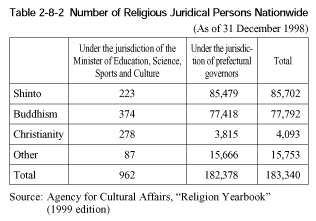| Home > Policy > White Paper, Notice, Announcement > White Paper > Japanese Government Policies in Education, Science, Sports and Culture 2000 > Part 2 Chapter 8 Section 5 1 | ||
In Japan, there currently exist a number of large-scale religious groups for of a particular denomination, sect or order, as well as religious organizations of all sizes such as shrines, temples, and churches, and these bodies conduct a diverse range of religious activities. Of these, approximately 183,000 religious organizations have been designated as religious juridical persons based on the Religious Juridical Persons Law (See Table 2-8-2 ).

The objective of the Religious Juridical Persons Law, which established the religious juridical persons system, is to establish a material base to enable religious organizations to conduct free and independent activities. The religious juridical persons system, based on the principles of freedom of religion and separation of church and state guaranteed by the Constitution, entrusts each religious juridical person with the autonomy and independence to manage its own affairs, with the least possible involvement by the authorities concerned, in order to ensure that religious juridical persons are able to perform their activities as freely as possible. At the same time, it clarifies the responsibilities of religious juridical persons, making public aspects the essential feature of the entire system.
| Back to Top | MEXT HOME |